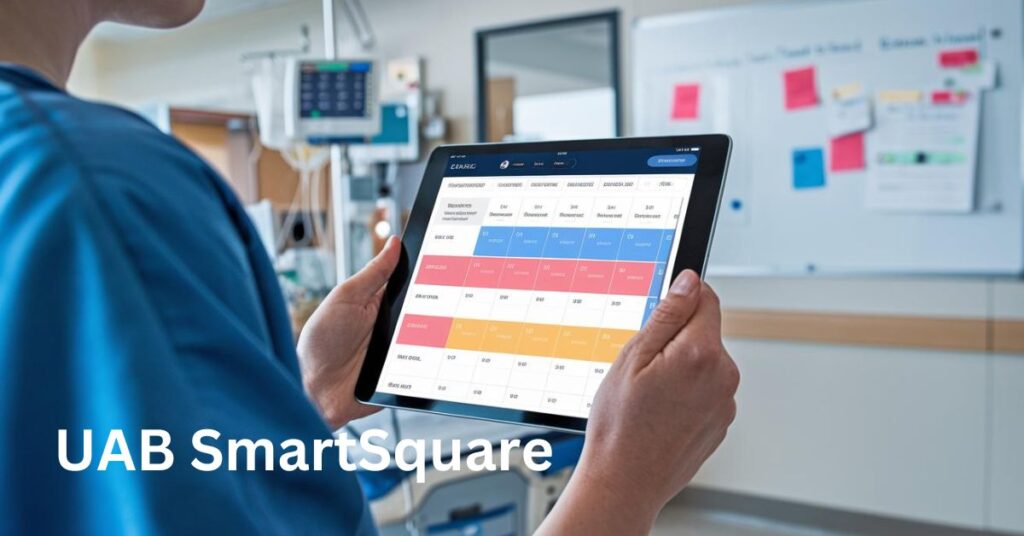In the fast-paced world of healthcare, efficient and accurate staff scheduling is vital. The UAB SmartSquare application has emerged as a game-changer in this aspect.
Designed to simplify and optimize the scheduling process, this innovative tool enables healthcare facilities, particularly the University of Alabama at Birmingham (UAB), to effectively manage staff resources. In this article, we’ll explore why UAB SmartSquare is essential for healthcare professionals and how it benefits both managers and employees.
What is UAB SmartSquare?
The UAB SmartSquare is an advanced workforce management tool designed to streamline shift scheduling. It automates the process of assigning shifts, making real-time adjustments, and ensuring optimal staff-patient ratios. It caters specifically to the healthcare industry, where time management and resource optimization are crucial for delivering quality care.
Why Use the UAB SmartSquare App?

There are several reasons why UAB SmartSquare is widely adopted in healthcare facilities:
1. Automation of Shift Scheduling:
One of the standout features of UAB SmartSquare is its ability to automate shift scheduling. The manual process of creating and managing schedules can be time-consuming and prone to errors. UAB SmartSquare eliminates these challenges by automating shift assignments, ensuring that the right personnel are assigned to the right roles at the right times.
2. Real-Time Updates:
The healthcare environment is dynamic, and shift changes are often necessary at short notice. UAB SmartSquare allows managers to make real-time changes to schedules, accommodating last-minute requests and emergencies. This flexibility helps maintain efficient operations even in unpredictable circumstances.
3. Optimized Staff-Patient Ratios:
Proper staffing levels are crucial to delivering high-quality patient care. UAB SmartSquare ensures that staff-to-patient ratios are maintained at optimal levels, which helps prevent burnout and ensures that patients receive the attention they need. By balancing workloads effectively, the app contributes to both employee satisfaction and patient care outcomes.
Key Features of UAB SmartSquare:
UAB SmartSquare offers several features that set it apart from traditional scheduling systems:
1. User-Friendly Interface:
The UAB SmartSquare platform is designed to be easy to use for both managers and staff. Its intuitive interface allows users to navigate through scheduling tasks with minimal training, making it accessible for everyone in the healthcare setting.
2. Customizable Scheduling Options:
Every healthcare facility has unique needs, and UAB SmartSquare allows for customizable scheduling. Managers can set specific parameters for different departments, ensuring that each unit is appropriately staffed based on their unique demands.
3. Employee Self-Service:
With UAB SmartSquare, employees have access to self-service features that allow them to view their schedules, request time off, and swap shifts with colleagues. This level of autonomy empowers employees and reduces the administrative burden on managers.
4. Mobile Accessibility:
The UAB SmartSquare app is mobile-friendly, allowing both managers and employees to access the system from their smartphones. This feature is particularly beneficial for staff who need to check their schedules on the go or make urgent shift changes outside of work hours.
Benefits of UAB SmartSquare for Healthcare Managers:
For healthcare managers, UAB SmartSquare offers several advantages that make workforce management more efficient:
1. Time-Saving Automation:
The automation features of UAB SmartSquare significantly reduce the time spent on manual scheduling. Managers can allocate more time to other critical tasks, improving overall operational efficiency.
2. Improved Staff Utilization:
With UAB SmartSquare, managers can ensure that staff are used efficiently across different departments. By analyzing staffing patterns and patient needs, the app helps allocate resources where they are needed most.
3. Enhanced Communication:
Real-time updates and notifications from UAB SmartSquare ensure that managers and employees are always on the same page. This reduces miscommunication and scheduling conflicts, which can lead to improved overall workplace harmony.
Benefits of UAB SmartSquare for Healthcare Employees:
For healthcare employees, UAB SmartSquare provides several key benefits:
1. Greater Control Over Schedules:
Employees can view and manage their schedules easily through UAB SmartSquare. The ability to request time off or swap shifts offers flexibility, contributing to a better work-life balance.
2. Transparency:
With UAB SmartSquare, employees have complete visibility into their shift patterns and staffing levels. This transparency fosters trust and reduces the likelihood of misunderstandings about schedules.
3. Reduced Scheduling Conflicts:
Because UAB SmartSquare offers real-time updates, employees are less likely to experience scheduling conflicts. This ensures that shifts are adequately covered, leading to smoother operations and fewer last-minute adjustments.
How UAB SmartSquare Enhances Patient Care?
By optimizing staff scheduling and maintaining appropriate staff-patient ratios, UAB SmartSquare directly impacts patient care in a positive way. Proper staffing ensures that healthcare professionals are not overburdened, which allows them to provide attentive, high-quality care to patients.
Additionally, the ability to make real-time changes ensures that staffing levels can be adjusted to meet fluctuating patient needs, improving outcomes and patient satisfaction.
Integration with Other Healthcare Systems:
UAB SmartSquare excels not only as a standalone tool but also in its ability to integrate seamlessly with other healthcare management systems. For healthcare facilities using electronic health records (EHR) and other patient management systems, UAB SmartSquare provides a cohesive experience by syncing scheduling data with patient care information.

This integration allows for more accurate staffing based on real-time patient data, such as the number of patients in each unit or specific patient needs.
By aligning scheduling with patient acuity levels and ongoing treatments, UAB SmartSquare helps ensure that the right staff members are available to provide the necessary care, enhancing overall efficiency and patient outcomes.
Data Analytics and Reporting:
Another notable feature of UAB SmartSquare is its robust data analytics and reporting capabilities. The application generates detailed reports on various aspects of scheduling, such as shift coverage, overtime costs, and staff utilization.
This data-driven approach provides managers with valuable insights into scheduling patterns and resource allocation. By analyzing historical data and trends, managers can make informed decisions about staffing levels and identify areas where adjustments may be needed.
For instance, reports can reveal peak times when additional staff may be required or highlight shifts that frequently experience shortages. This proactive approach enables healthcare facilities to optimize their operations continuously.
Compliance and Regulatory Adherence:
Compliance with healthcare regulations and labor laws is a critical concern for any healthcare facility. UAB SmartSquare assists in this area by ensuring that scheduling practices adhere to legal and regulatory requirements.
The app includes features that help track compliance with work-hour regulations, mandatory rest periods, and other labor laws. Automated alerts and notifications can be set up to ensure that managers are aware of any potential compliance issues before they become problematic.
By maintaining rigorous adherence to these standards, UAB SmartSquare helps facilities avoid legal issues and penalties, ensuring a smooth and compliant operational process.
Training and Support for Users:
Implementing a new scheduling system can often be daunting for staff, but UAB SmartSquare addresses this concern with comprehensive training and support resources.
The application provides various training modules and user guides designed to help both managers and employees become proficient with the system. Interactive tutorials and support from the UAB SmartSquare team ensure that users can navigate the platform confidently and efficiently.
Additionally, ongoing customer support is available to address any issues or questions that may arise. This commitment to user education and support helps to facilitate a smoother transition to the new system, ensuring that its benefits are fully realized from the outset.
Enhanced Communication and Coordination:
Effective communication is crucial in a healthcare setting, and UAB SmartSquare enhances this through its integrated communication features. The platform facilitates seamless coordination between managers and staff by providing a centralized hub for scheduling-related messages and notifications.
This includes automated alerts for upcoming shifts, shift changes, and urgent staffing needs. The messaging system within UAB SmartSquare allows staff to communicate directly with each other, request coverage, and provide updates on their availability.
By centralizing communication, UAB SmartSquare reduces the chances of missed messages and misunderstandings, leading to more efficient and effective coordination within the team.
Customizable Alerts and Notifications:
UAB SmartSquare offers customizable alert and notification options that help managers and staff stay on top of important scheduling details. Managers can set up alerts for various scenarios, such as when a shift is unfilled, when overtime thresholds are approached, or when compliance issues arise.

Staff members also receive notifications for shift assignments, changes, and upcoming shifts, which can be tailored to their preferences. This level of customization ensures that all users receive timely and relevant information, allowing them to act promptly and make necessary adjustments.
Customizable alerts contribute to a more proactive approach to scheduling and help prevent issues before they escalate.
Scalability and Adaptability:
One of the strengths of UAB SmartSquare is its scalability and adaptability to different healthcare environments. Whether managing a small clinic or a large hospital network, the application can be scaled to meet varying needs and requirements.
UAB SmartSquare can handle complex scheduling scenarios, including multi-location operations and diverse departments with unique staffing needs.
The system’s adaptability allows it to integrate with other tools and processes within a healthcare facility, ensuring that it remains effective as the organization grows or changes. This scalability makes UAB SmartSquare a versatile solution for healthcare facilities of all sizes.
Impact on Employee Satisfaction and Retention:
The implementation of UAB SmartSquare has a notable impact on employee satisfaction and retention. By automating scheduling and providing employees with greater control over their shifts, the platform helps address common issues related to work-life balance and job satisfaction.
The ability to easily request time off, swap shifts, and view schedules in advance reduces stress and uncertainty for staff members. Additionally, transparent scheduling practices and fair shift distribution contribute to a positive work environment. Improved job satisfaction often leads to higher retention rates, which is beneficial for maintaining a stable and experienced workforce in the healthcare setting.
Conclusion:
The UAB SmartSquare application is transforming healthcare scheduling by automating processes, providing real-time updates, and optimizing staff-patient ratios. Both healthcare managers and employees benefit from the flexibility, efficiency, and transparency that UAB SmartSquare offers. For healthcare facilities like UAB, implementing UAB SmartSquare not only improves operational efficiency but also enhances the quality of patient care.
By adopting UAB SmartSquare, healthcare institutions are better equipped to meet the challenges of modern healthcare delivery, ensuring that both staff and patients experience the best possible outcomes.


